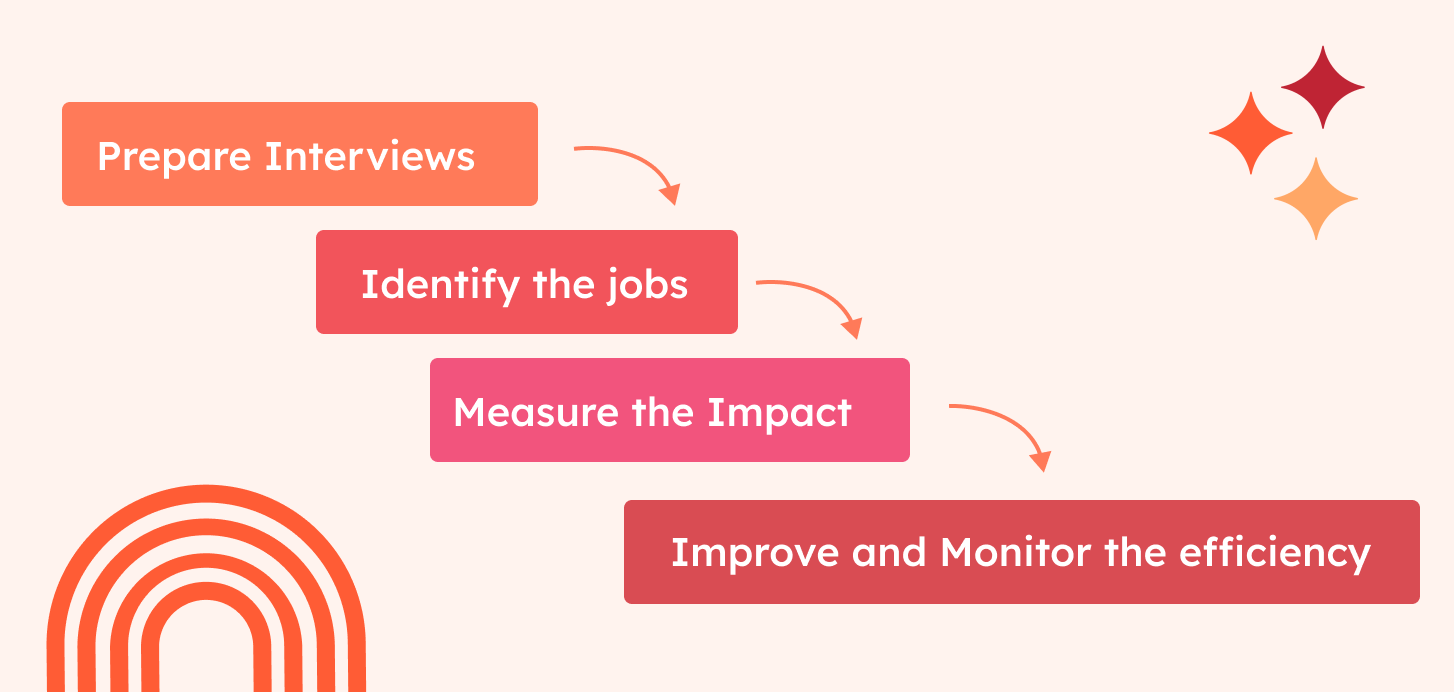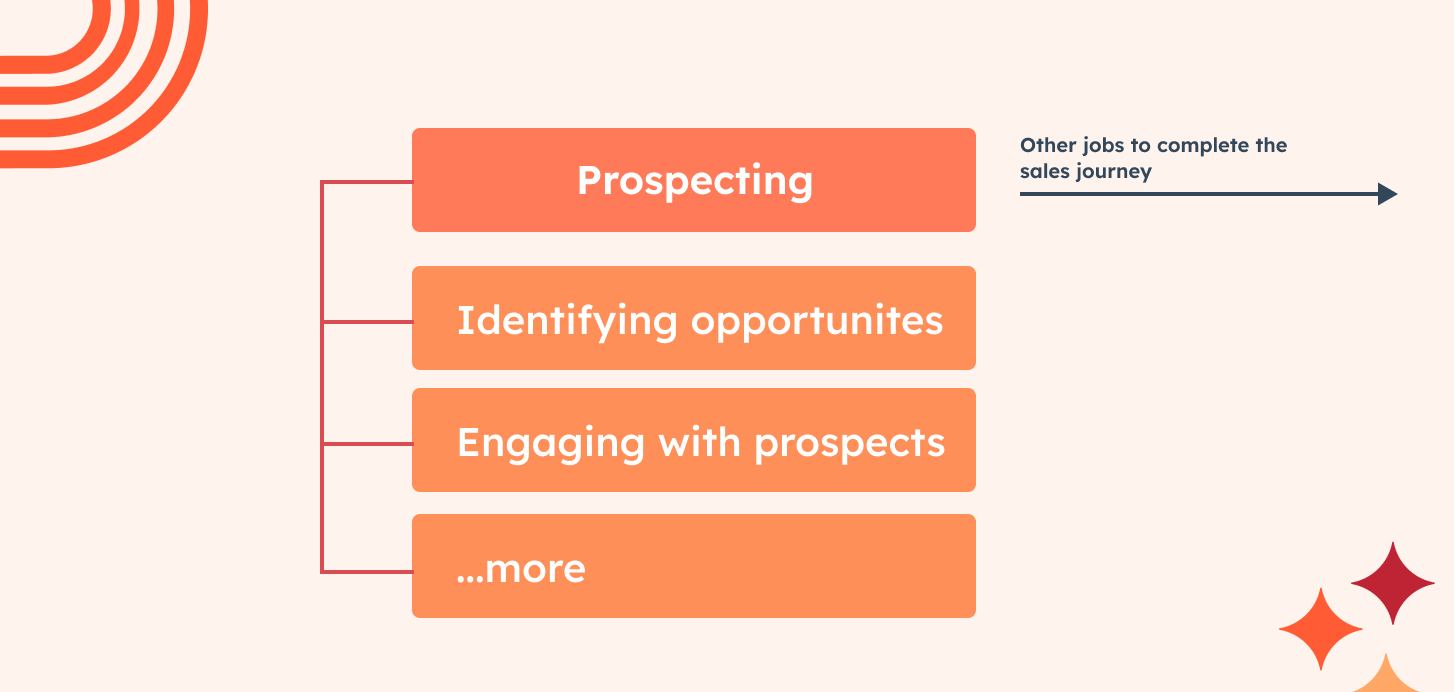Written by Renann Devlin, Senior Product Designer @ HubSpot.
HubSpot's sales team reps rely on multiple tools to accomplish their day to day activities. However, for our design team, the largest problems to solve require understanding the precise nature of the challenges internal reps face and determining how to enhance the systems and processes they use to optimize their efficiency. Initiatives like this present unique ambiguity, as the sales domain encompasses many touchpoints and crucial steps in supporting our customers.
In this post, we’ll show you how the Flywheel Design Team at HubSpot recently used the Jobs To Be Done (JTBD) framework to understand the challenges our sales team are facing, and how you can apply this framework to your own teams.
_________________
The challenge
As HubSpot scales its sales team, it's crucial that our systems support this desired growth and enable our reps to effectively assist customers while identifying solutions that drive value and growth for their businesses.
Before embarking on this journey, we had first signals and assumptions about the challenges impacting our reps. However, given the global footprint of our sales organization, it was imperative to gain a comprehensive understanding of the diverse impacts across regions and segments.
Aligned with the mission of the Flywheel product team, which is to enable HubSpot to grow better, we partnered with key stakeholders to bring our evolving go-to-market (GTM) strategy to life through best-in-class technology solutions. These solutions empower our customer-facing reps and partners to excel in revenue generation and foster customer loyalty.
To bridge the gap between our mission and the challenges faced in sales, we delved deep into the sales space using the Job To Be Done (JBTD) framework. This allowed us to organize our findings and develop a comprehensive sales journey map, which revealed valuable opportunities for improvement.
What is the Job To Be Done (JTBD) Framework?
Tony Wulkick, an author and innovation thought leader, highlights that every individual has underlying problems they are seeking to solve. They have specific goals they want to achieve and tasks they need to complete. Additionally, they may meet situations they wish to avoid. In these scenarios, people often turn to products and services to help them accomplish a particular "job."
The JTBD framework is a user-centric approach to innovation that focuses on understanding customer needs based on the functional, emotional, and social aspects of the jobs they are trying to fulfill. Its goal is to support the design of experiences, services, and products that align with their desires.
By comprehending the goals and tasks that users are striving to carry out, you can effectively reach them through tailored strategies. Your messaging should be crafted to resonate with their motivations, and you should be able to show how your offerings are the best fit for their needs. This user-centric approach allows for a more targeted and impactful engagement with customers, leading to greater satisfaction and success.
Clayton Christensen, a Harvard Business School professor and disruptive innovation expert, shared an example of how JTBD can be applied.
The Jobs type and structure
A “job” to be done is basically a target that somebody is seeking to reach in any given context. It's about what people desire to attain, not about the solution. The format is: verb + object + clarifier. This activity helped us think inventively about techniques to handle our reps' primary difficulties.
An example:

What to consider while writing the jobs:
- Situation: When a task or job arises, it's important to understand the individual requirements for completing it.
- Needs: this may include minimizing the time it takes to compile documents, maximizing the chance of getting a refund, and reducing the effort needed to choose the correct conference to attend.
- Expected outcome: The final objective of the job should be expresses as "so I can...", which might overlap with motivations and needs.
By considering the timing of when a job needs to be done, the motivations driving the sales reps, and the specific results they desire, we were able to align our product offerings and improvements to better meet their needs. This approach allowed us to focus on delivering solutions that directly addressed the key tasks and goals of our sales reps, ultimately increasing their productivity and effectiveness.
How did we find jobs?

Preparing
Our approach began with conducting interviews, taking into consideration the following aspects:
- Defining the Target sales group and schedule interviews.
- Preparing questions that helped team understand their activities and the tools they use to achieve their goals.
For instance, we asked questions such as:
- "Could you tell me about your daily tasks?"
- "What apps do you use to accomplish these tasks?"
- "What challenges do you face in your workflow?"
- "What obstacles prevent you from completing your tasks?"
The most important aspect was understanding the barriers and frustrations that hindered them from achieving their goals. We observed their behaviors and methods of task completion, meticulously documenting everything.
It is crucial to involve the entire team in these interviews, as it is not solely the responsibility of user experience researchers and designers. By including the team, we can collectively uncover the underlying needs and goals.
Additionally, we conducted a debrief call after each interview. This allowed for valuable discussion, alignment, and the sharing of different perspectives before adding notes to the findings.
Identifying jobs
Following the completion of the interviews, we embarked on the task of organizing and analyzing the notes, which proved to be a significant undertaking. During the review process, we were able to find emerging trends and common patterns of problems. To further analyze the findings, we used the following approach:
- Conducted an affinity mapping team workshop:
- Organized the notes to identify patterns and connections across the interviews.
- Grouped the notes based on activities/tasks and their expected outcomes.
- Utilized the Situation / Motivation / Outcome framework:
- Rewrote the identified themes using a structured format of verb + object + clarifier.
- This framework helped provide a clear understanding of the situation, the motivation it, and the desired outcome.
By using these methods, we were able to effectively analyze the interview findings and gain valuable insights into the challenges and opportunities identified during the process.
Mapping out jobs

After the synthesis of our findings, we collected the identified "jobs to be done" and proceeded to map them out in a journey map. This visual representation allowed us to highlight problem areas, capture reps' sentiments, find opportunities, and focus on actions.
To gain further insights, we created a survey based on the identified jobs and asked our team to rank them using the satisfaction score method. This approach helped us understand the level of pain associated with each job, from the most challenging to the most satisfying. The survey did not need to be lengthy; we focused on defining 10 important jobs and requested ratings and comments for each.
Once the survey responses were collected, we ranked the jobs based on the scores obtained. Sharing these findings with our users was also an option, as it allowed us to validate the identified jobs and make any necessary adjustments based on their feedback.
Improve + Monitor
After obtaining the scores, we explored potential improvements that could enhance reps efficiency. This was achieved through a team brainstorming session, as well as by reviewing system usage, conducting usability tests, and monitoring relevant metrics.
In addition, conducting quarterly surveys is recommended to gauge user satisfaction and gather valuable feedback.
Furthermore, once the product strategy was established, a more extensive research initiative was undertaken to gain deeper insights into user motivation and expected outcomes. This will provide a comprehensive understanding of user needs and enable the development of targeted solutions.
What were the results?

As a result of our efforts, we successfully raised awareness of the jobs and motivations of our sales reps. We also gained a deeper understanding of the negative impacts caused by system issues, which were hindering their ability to achieve their goals. To address these challenges, we implemented improvements aimed at enhancing the management of deals and prospect opportunities, ultimately increasing the efficiency of our sales reps.
Using the list of jobs we created, we developed an overview of efficient touchpoints that could be shared with stakeholders. This overview served as a justification for and prioritization of the improvements we proposed.
We utilized journey maps to visually represent the connections between the identified jobs. This approach proved to be highly effective in highlighting the importance of areas that were previously overlooked or were acting as obstacles to sales reps' productivity.
What did we learn?
Working within this framework, we recognized the importance of sharing the workload and maintaining effective communication during the interview process. We understood that conducting interviews was a team effort rather than solely a responsibility of the designers. Taking comprehensive notes played a crucial role in keeping us focused and capturing the necessary level of detail.
To ensure ongoing success, we emphasize the need to measure changes over time and maintain close relationships with our sales reps. This allowed us to refine the identified jobs and conduct new surveys as needed.
For similar challenges, we found the JTBD framework to be a valuable tool. It helped us uncover potential opportunities for innovation and growth by continuously monitoring the evolving job landscape. This framework provided insights that extended beyond the current product iteration, enabling us to gain a comprehensive understanding of our customers' needs.
Are you ready to make an impact? Check out our careers page for your next opportunity! And to learn more about our culture, follow us on Instagram @HubSpotLife.
